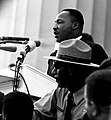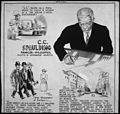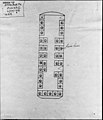Portal:Civil rights movement
The civil rights movement portal The civil rights movement was a social movement and campaign from 1954 to 1968 in the United States to abolish legalized racial segregation, discrimination, and disenfranchisement in the country. The movement had its origins in the Reconstruction era during the late 19th century and had its modern roots in the 1940s, although the movement made its largest legislative gains in the 1960s after years of direct actions and grassroots protests. The social movement's major nonviolent resistance and civil disobedience campaigns eventually secured new protections in federal law for the civil rights of all Americans. After the American Civil War and the subsequent abolition of slavery in the 1860s, the Reconstruction Amendments to the United States Constitution granted emancipation and constitutional rights of citizenship to all African Americans, most of whom had recently been enslaved. For a short period of time, African-American men voted and held political office, but as time went on Blacks were increasingly deprived of civil rights, often under the racist Jim Crow laws, and African Americans were subjected to discrimination and sustained violence by white supremacists in the South. Over the following century, various efforts were made by African Americans to secure their legal and civil rights, such as the civil rights movement (1865–1896) and the civil rights movement (1896–1954). The movement was characterized by nonviolent mass protests and civil disobedience following highly publicized events such as the lynching of Emmett Till. These included boycotts such as the Montgomery bus boycott, "sit-ins" in Greensboro and Nashville, a series of protests during the Birmingham campaign, and a march from Selma to Montgomery. At the culmination of a legal strategy pursued by African Americans, in 1954 the Supreme Court struck down the underpinnings of laws that had allowed racial segregation and discrimination to be legal in the United States as unconstitutional. The Warren Court made a series of landmark rulings against racist discrimination, including the separate but equal doctrine, such as Brown v. Board of Education (1954), Heart of Atlanta Motel, Inc. v. United States (1964), and Loving v. Virginia (1967) which banned segregation in public schools and public accommodations, and struck down all state laws banning interracial marriage. The rulings played a crucial role in bringing an end to the segregationist Jim Crow laws prevalent in the Southern states. In the 1960s, moderates in the movement worked with the United States Congress to achieve the passage of several significant pieces of federal legislation that authorized oversight and enforcement of civil rights laws. The Civil Rights Act of 1964 explicitly banned all discrimination based on race, including racial segregation in schools, businesses, and in public accommodations. The Voting Rights Act of 1965 restored and protected voting rights by authorizing federal oversight of registration and elections in areas with historic under-representation of minority voters. The Fair Housing Act of 1968 banned discrimination in the sale or rental of housing. (Full article...) Selected article - The women's poll tax repeal movement was a movement in the United States, predominantly led by women, that attempted to secure the abolition of poll taxes as a prerequisite for voting in the Southern states. The movement began shortly after the ratification in 1920 of the Nineteenth Amendment to the United States Constitution, which granted suffrage to women. Before obtaining the right to vote, women were not obliged to pay the tax, but shortly after the Nineteenth Amendment became law, Southern states began examining how poll tax statutes could be applied to women. For example, North and South Carolina exempted women from payment of the tax, while Georgia did not require women to pay it unless they registered to vote. In other Southern states, the tax was due cumulatively for each year someone had been eligible to vote. Payment of the tax was difficult for Black, Hispanic, and women voters, primarily because their incomes were much lower than those of white men. For married women, coverture prevented them from controlling their own assets. Recognizing that payment of the tax as a prerequisite to voting could lead to their disenfranchisement, women began organizing themselves in the 1920s to repeal the poll tax laws, but the movement did not gain much traction until the Great Depression in the 1930s. Both black and white women pressed at state and national levels for legislative action to abolish laws that required paying to vote. In addition, women filed a series of lawsuits to try to effect change. By the 1950s, the intersection of sexist and racist customs and law was apparent to those fighting the poll tax. This created collaborations between activists involved in the poll tax movement and those active in the broader civil rights movement. Louisiana abandoned its poll tax law in 1932, and the number of women voters increased by 77 percent. Women's activism helped bring about the repeal of poll tax legislation in Florida in 1937, in Georgia in 1945, in Tennessee in 1953, and in Arkansas in 1964. That year, the Twenty-fourth Amendment to the United States Constitution was passed, prohibiting poll taxes as a barrier to voting in federal elections. Passage of the Voting Rights Act of 1965 gave federal authority to the Department of Justice to institute lawsuits against the four states that still used poll tax to disenfranchise voters in state elections. The Supreme Court finally settled the four-decades-long struggle, abolishing the requirement to pay poll tax to be able to vote in any election, federal or state, in their ruling on Harper v. Virginia State Board of Elections in 1966. (Full article...)General imagesThe following are images from various civil rights movement-related articles on Wikipedia.
Related portalsWikiProjectsSelected biography -Viola Fauver Liuzzo (née Gregg; April 11, 1925 – March 25, 1965) was an American civil rights activist in Detroit, Michigan. She was known for going to Alabama in March 1965 to support the Selma to Montgomery march for voting rights. On March 25, 1965, she was shot dead by three Ku Klux Klan members while driving activists between the cities and transportation. Also in the pursuit car was an undercover informant working for the Federal Bureau of Investigation (FBI). His role in this and other events was not revealed until 1978. To deflect attention from the FBI, its head J. Edgar Hoover made defamatory claims about Liuzzo. (Full article...)Selected image - Civil rights activists stage a sit-in at Woolworth's in Durham, NC to protest against racial segregation. (10 February 1960)
Did you know?
TopicsSubcategoriesThings to doAssociated WikimediaThe following Wikimedia Foundation sister projects provide more on this subject:
Discover Wikipedia using portals
|





















































